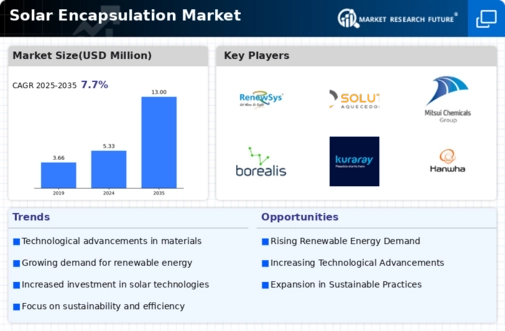Major market players are spending a lot of money on R&D to increase their product lines, which will help the Solar Encapsulation Market grow even more. Market participants are also taking a range of strategic initiatives to grow their worldwide footprint, including new product launches, contractual agreements, mergers and acquisitions, increased investments, and collaboration with other organizations. Competitors in the Solar Encapsulation Market industry must offer cost-effective products to expand and survive in an increasingly competitive and rising market environment.
One of the primary business strategies adopted by manufacturers in the global solar encapsulation industry to benefit clients and expand the Solar Encapsulation market sector is partnerships and acquisitions. The market for Solar Encapsulation is recognized as being extremely competitive and fragmented.
The market for Solar Encapsulation offers considerable potential opportunities for domestic and unorganized companies. Some of the key players operating in the market are 3M (U.S.), Dow Inc. (U.S.), DuPont (U.S.), Arkema (France), Specialized Technology Resources (U.S), RenewSys (India), Solutia (U.S.), Mitsui Chemicals (Japan), Hangzhou First Applied Material (China), Borealis (Netherland), Kuraray (Austria), Hanwha (Japan), Targray (South Korea), and dnpSolar (Canada). To increase their global reach and client base, key firms are concentrating on acquisitions and product innovation.
3M.: 3M offers diversified technology products, and has a global presence. 3M is one of the leading manufacturers of products that serves a wide range of the industry verticals. The company offers more than 60,000 products that are used in homes, businesses, schools, hospitals and other industries.
The company operates in the business segments including safety and Construction, transportation and electronics, health care, and consumer. Moreover, 3M has corporate operations across 70 countries and sales in 200.3M products are sold through various distribution channels such as directly to users and through different e-commerce as well as traditional wholesalers, retailers, jobbers, distributors and dealers across variety of trades in many countries in the world.
Dow Inc.: Dow is one of the leading materials science companies. The company offers solutions including plastics, Construction intermediates, coatings and siliconesfor consumer care, infrastructure, and packaging industries.Dow operates across various countries and regions of world including the United States, Canada, Europe, the Middle East, Africa, India, the Asia Pacific, and Latin America.
The company operates through its six major segments including Packaging, Specialty Plastics, Construction Intermediates, Infrastructure, Performance Materials and Coatings. The Packaging & Specialty Plastics segment of Dow offer functional polymers, such as polyolefin elastomers, semiconductive and jacketing compound solutions and wire and cable insulation. The ENGAGE PV Polyolefin Elastomers (POE) by Dow is used for PV encapsulant films due to its long-term performance, reliability and lower overall costs.

















